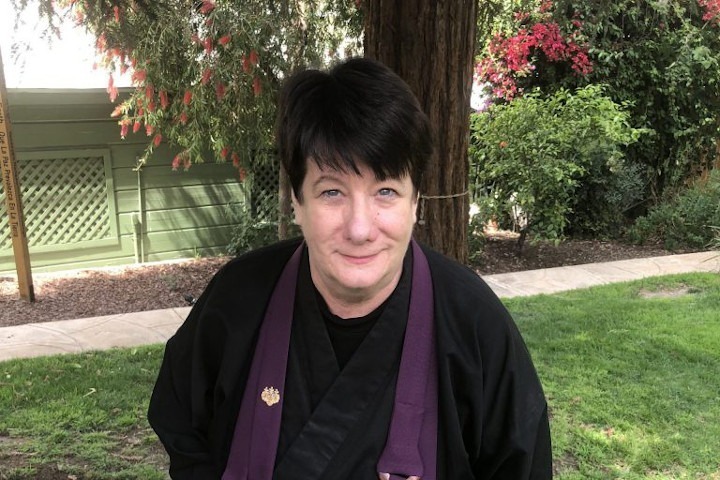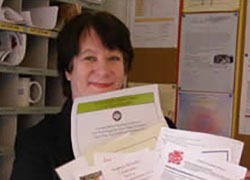
Nothing in this World Frightens Me
October 1, 2022
 by Katherine Daiki Senshin Griffith
by Katherine Daiki Senshin Griffith
One day when Master Joshu was outside the monastery, he saw an old woman hoeing a field. He asked her, “What would you do if you suddenly met a fierce tiger?” She replied, “Nothing in this world frightens me,” and turned back to her hoeing. Joshu roared like a tiger. She roared back at him. Joshu said, “There’s still this.”
– The Hidden Lamp
As we move into the last quarter of the Year of the Tiger, many of us find the world a frightening place: ever new variants of the virus, accelerating effects of climate change, our democracy threatened, erosion of rights, economic uncertainty, political divisions, the war in Ukraine with its global repercussions, increasing exposure of how ingrained and systemic racism is in our culture.
What is it like to be able to say: “Nothing in this world frightens me?” Why was the old woman able to say that and roar so completely?
Chances are she’d spent a lifetime hoeing that very field. Like the women I saw in the mountain rice fields of Japan, who’d spent their lives bent over so they could no longer stand upright. In hoeing her hard dry soil, this old woman was completely doing what needed to be done, serving her family, providing food, perhaps contributing to income. In tune with both its harshness and beauty, farmers engage directly with nature and its inescapable elements of wind, rain, drought, and pestilence.
The old woman knew that soil intimately: the rocks, weeds, worms, bugs. She didn’t curse her conditions, just tilled away so it was ready for a new crop. But she also cultivated her mind, so she was ready for anything. Like it says in the koan, “empty-handed, yet holding a hoe.”
Isn’t that what we are doing in our Zen practice? When we till the soil of our minds, we learn that landscape intimately with its distractions, anxiety, greed, anger, laziness, doubt, perfectionism, impulsiveness, judgement, confusion, fatigue, irritability, ignorance, earnestness, excitement, restlessness, self-consciousness. Whatever comes up, we just hoe, hoe, hoe.
Like the old woman, we don’t curse or judge our ingredients, but just till away and do what’s needed, in tune with our inner and outer atmospheres. We too can be empty-handed: sending an email, recycling the trash, looking for work, sitting by a hospital bed, lying in a hospital bed, dying in a hospital bed. When the self is dropped, we are available for creative problem-solving and facing whatever is before us. Even our fear and anxiety.
If I don’t accept the process something requires – as in a writing project – it’s miserable. But if I accept the process itself, work with what’s there, then empty-handed, I can flesh out an idea, rewrite, cut or even throw it all away and grow a new kind of crop. Then all the heaving and hoeing can be joyful. A dear friend of mine fell off the stage and was paralyzed from the neck down. Yet he kept creating, writing, designing, making art, even performing.
The old woman was so empty of self, so completely absorbed in the task, she blended with the whole vista. And yet Master Joshu noticed her. How many hidden lamps do we overlook in our lives? All the essential workers that are taken for granted, teachers unnoticed, elders dismissed.
He asked her, “What would you do if you suddenly met a fierce tiger?” (Be careful when a Zen master asks a seemingly ordinary question.) What did he see that made him question her? Was she so absorbed in her task? Was she just so fascinating he couldn’t resist? Was he remembering other impressive old women who had taught him the dharma and revealed their marrow? Did she already seem fearless?
And what is this ferocious tiger? Was Master Joshu referring to himself as a fierce master challenging her? Is the tiger the True Nature of the Dharma? Is the hungry tiger our endless appetite and was he asking how she deals with craving and suffering? Was he asking how do you encounter the Essence of Life? Or did his one question skewer through all these points?
Her answer certainly blasted through all questions. Nothing in this world frightens me. What was the source of her confidence? Or confidence in the source?
The Dhammatthavinicchaya Sutra talks about how when endowed with the Four Confidences of the Buddha, the Realized One claims the place of the leader, and roars the lion’s roar among the assembly, and sets rolling the supreme wheel. The Four Confidences are 1) complete and perfect self-enlightenment; 2) total elimination of all mental fermentation; 3) knowing and seeing all obstructions as obstruction; and 4) teaching a Dharma which unambiguously always leads to the complete ceasing of all suffering. These are the certainty, assurance, safety and fearlessness a Buddha enjoys. So endowed with these confidences the Realized One roared his teaching which still reverberates with us at this very moment. What do we do when we can’t yet roar the lion’s roar? Hoe, hoe, hoe.
Tigers have been a Chinese cultural symbol for over 7000 years, representing willpower, courage, physical and inner strength. A Chinese idiom says: “ Tiger roaring and dragon singing – the world is peaceful.” It’s said a dragon’s roar gathers clouds; a tiger’s raises winds. Together they are a formidable force, that can create a storm. They represent the opposing polar, yet balancing forces of yin and yang, female and male energies, respectively.
An ancient story tells about the confrontation between a Tiger and a Dragon. One day a hermit saw a large yellow Dragon playing with a pearl in the sky. Then a white Tiger, scared of the dragon’s claws, came out of hiding. The Dragon just ignored him. The Tiger, furious over such disdain, declared that he was the King of All Animals and demanded that the Dragon acknowledge that. Enraged, the Dragon said the Tiger was King of the Furry animals and he, the Dragon was King of the Scaley and Symbolic animals. Rather than physically fight, the Tiger began an Oratory Duel, with a magnificent roar. The Dragon spoke with its breath and said that it could bring peace on earth and had done so many times. Their verbal battle over
who was the most terrifying and powerful went on for a thousand years revealing the great qualities of both mythic creatures.
The witnessing hermit asked a philosopher what the meaning behind this amazing joust was. The philosopher said two complimentary fundamental principles, Yin and Yang, a combination of heaven and earth, produced these extraordinary animals. The Yin principle represents the Tiger, the Yang the Dragon. In essence, the world is controlled by a cosmic duality of opposing principles or cosmic energies that may be observed in nature, moving and transforming each other.
Indeed, everywhere in the Universe, there is a part of the Tiger and part of the Dragon – intimately intertwined. Our search for perfection or balance requires the participation of both these parts. It is necessary to unite the strength of the Tiger with the spirit of the Dragon. With any duality, we can recognize this complementary aspect and examine the imbalance to maintain equilibrium. However, when these energies become misaligned, we may experience anxiety, inner division and disease.
Joshu roared like a tiger. She roared back at him. Like the Dragon and the Tiger, they were inseparable from each other. Like two arrows meeting in midair, all dualistic viewpoints roared away: existence and non-existence, the myriad and the one, good and bad, fear and no fear.
Then Joshu said, “ There’s still this.” What is this “still this?” This is the most important aspect. When all the roaring ends, is there anything left? What is the inexhaustible roar? Chi Kuang Sunim, the Hidden Lamp commentator asks, “What is the great timeless, inner roar of no sound and where does it come from? Such inquiry points to a deep spacious stillness within, yet demands that we act now.”
After their roaring encounter, the Old Woman probably turned back to her hoeing. She had mouths to feed, crops to sew. In our practice, we too can simply return to what needs to be done, without fear. Back to the marketplace and Bodhisattva action. Back to our sitting, cultivating our field, working with whatever comes up. We still have this Dharma to use.
As it says in the introduction to “Suigan’s Eyebrows” Case 8 in the Blue Cliff Record:
The enlightened one enjoys perfect freedom in active life. Like a dragon supported by deep waters or like a tiger that commands its mountain retreat…
Here on Great Dragon Mountain, in the year of the Tiger, no matter how frightening the world appears, we can awaken to our true nature and experience:
Tiger roaring and dragon singing – the world is peaceful.
Sensei Senshin is the Head Teacher at ZCLA.
